Pakistan has been a cradle of civilizations through the ages. It possesses one of the oldest and most distinguished cultural heritages of the world. But archaeology has a very recent growth here. There is at present only one organization, the Department of Archaeology, which is actively engaged in field and laboratory investigations. Starting from a modest beginning since the independence of the country in 1947, it has created and developed gradually its essential technical branches, and is now quite well-equipped to undertake archaeological research work in both West and East Pakistan.
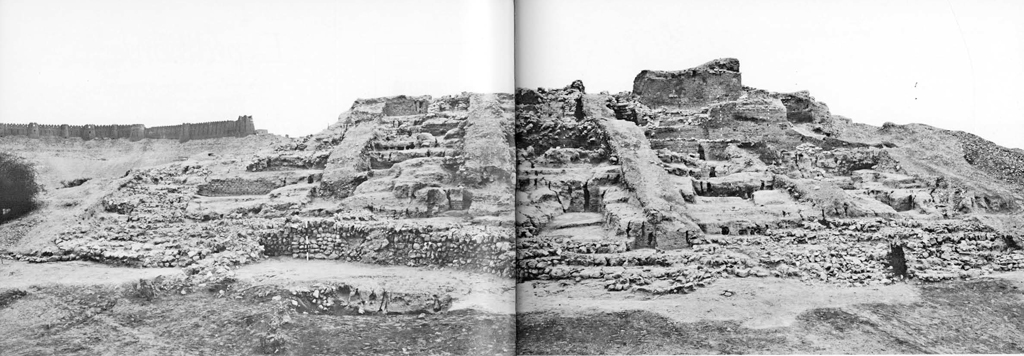
At present the Department is composed of a central Directorate in Karachi with three subordinate branches–the Exploration Branch, the Conservation Branch, and the Museum Branch. A Publication Branch has recently been added, but it is yet to be adequately developed. Two more necessary adjuncts of the Department, a well-equipped chemical laboratory and a central reference library, also deserve mention.
In a country so vast as Pakistan, possessing prehistoric and historic sites so large in number and varied in character, the Department of Archaeology has obviously an important task to perform. On it devolves the responsibility of systematically safeguarding and adequately exploring and interpreting Pakistan’s past. Briefly considered, its main tasks have been firstly, to initiate and finance field and laboratory researches, conserve ancient monuments, create and maintain museums, and secondly, to control and assist foreign archaeological expeditions.
In performing its tasks, the Department has been facing problems both complex and manifold; the major ones are concerned with conservation, but the archaeological ones are also not less important.
If these problems are to be solved by systematic archaeological method, careful planning is most essential. To excavate a site because it looks attractive or because it may produce some results is like plunging into darkness without knowing the consequences. In the past some of our ancient sites have been explored in this way. This is certainly not a scientific approach and is most unlikely to produce any significant result.
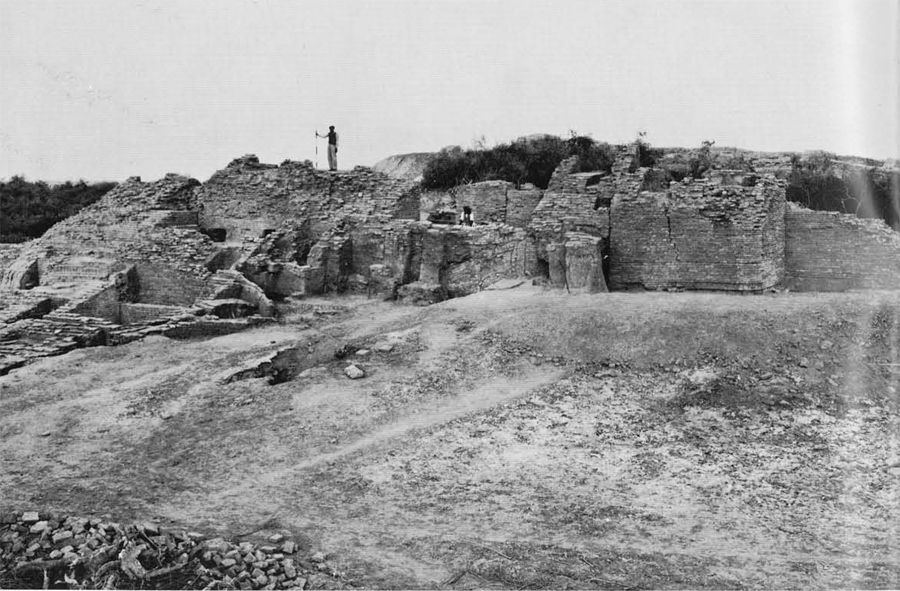
In our field work, two problems of outstanding importance need a scientific approach. The first relates to the “archaeological” gap in our knowledge of the post-Harappan cultural phases down to the invasion of the northwestern part of the subcontinent by the Achaemenians at the end of the 6th century B.C. The second problem relates to the early Muslim culture introduced by the Arabs and to the changes which it produced in the early part of the 8th century A.D.
The first problem is a standing challenge to all those who are engaged in the research work of that period and offers a number of questions who were the Indo-Aryans and where did they come from? Were they responsible for the mysterious disappearance of the Harappa-Mohenjo-daro civilization? Is there any archaeological evidence to identify the Indo-Aryans? These are some of the questions in which the archaeological problems of Pakistan are integral with those of the neighboring countries on the north and the west, and further advance is unlikely until extensive exploration and well planned excavations in Iran and Afghanistan provide fresh material. For this, close and constant mutual co-operation is essential.
The mature Harappa civilization, dated by Mesopotamian, Iranian, and Anatolian contacts in the middle of the third millennium B.C., when the Indo-Aryan invaders are said to have put an end to it.
For the invasion of the Indo-Aryans, we lack historical records and archaeological evidence–such as we possess for the subsequent invasions of the country by the Achaemenians in the 6th century B.C.; Alexander in 326 B.C.; the Sakas about 80 B.C.; the first Muslim conquerors in A.D. 712; Mahmud of Ghazni in A.D. 1001; the Turks in A.D. 1192; and finally the Moghuls in the year 1426.
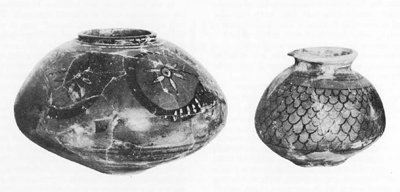
Yet, owing to its extent and the lasting character of its results, it is the invasion of the Indo-Aryans, who perhaps entered the Indus Valley sometime in the course of the mid-second millennium B.C., which has aroused the widest interest in scholarly circles all over the world.
As regards the invasion by the Indo-Aryans and the oft-supposed destruction of the Harappans at their hands, it is important to recall that there are more than a hundred sites of the Harappa culture widely distributed in the Indus Valley. It is true that only a few of them have been excavated and that at one site only, namely Mohenjo-daro, do we have evidence of the death of a group of people, and these number no more than thirty-five skeletons. Of violent destruction on any larger scale there is no evidence.
On the other hand, it is clear that in their later stages, the Harappan cities had suffered a considerable decline in material prosperity. To some extent pressure from floods and climatic changes may have been responsible. If the Indo-Aryans are a factor in this last phase, their hostility could only have a contributory effect in accelerating the end of that remarkable civilization. But in reality there remains in our mind a grave doubt whether these invaders could be connected at all with the collapse of the Harappa culture.
The Cemetery “H” period building remains discovered at the site of Harappa, lie superimposed on the thickly accumulated debris layers of the Harappa culture and represent a new intrusive element, as is evidenced by the distinctive black-on-red painted burial pottery. It has been suggested by more than one authority that the authors of the Cemetery “H” phase may have been the Indo-Aryan invaders.
But even the 1956 excavations conducted at Harappa by Sir Mortimer Wheeler, which revealed building remains of the Cemetery “H” period, did not yield any household objects and weapons of war or defence. Furthermore, the Cemetery “H” burials yielded neither weapons nor objects of domestic use which could give any clue for the identification of the inhabitants or for establishing their mode of life; nor do we as yet know of any parallel remains elsewhere to which they might be related. Thus, it would seem that the problem of identification of the Indo-Aryans and their possible role in the end of the Harappa culture remains unsolved.
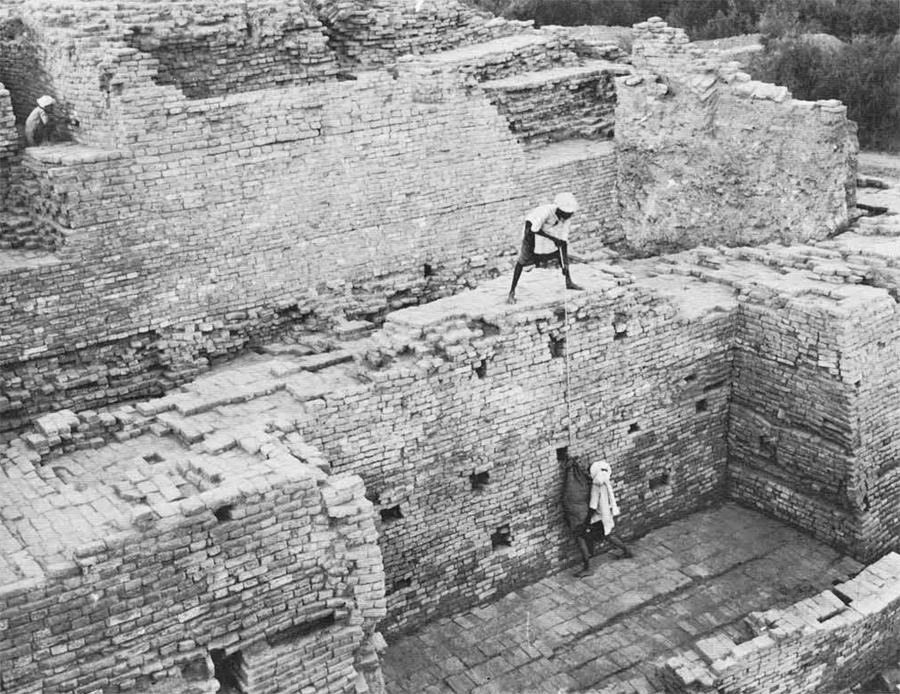
If we turn to the question of what traces the Indo-Aryans may have left along the line of communication which they followed before their migration to the subcontinent, it must be admitted that as yet archaeology does not help us. Their “archaeological” identity is still a mystery in Pakistan as it is in other parts of South Asia and the Near East. In Pakistan there is still a long time gap to be filled arcaheologically–possibly a thousand years–between the Cemetery “H” phase at Harappa and the invasion of the northwestern part of the Indus Valley by the Achaemenian Persians in the 6th century B.C.
Totally different in character from the Harappans is the culture of the Indo-Aryans as we know it from the descriptions in the Rig-Veda, the earliest religious texts of the subcontinent. The Vedic texts contain no reference to their life in large cities comparable to the remains of Harappa, Mohenjo-daro, or other contemporary settlements. The Indo-Aryans no doubt worshipped deities like Indra, Varuna, Mitra, Surya, and Agni. But as the Vedas cannot be dated even approximately, it is difficult to say in what chronological sequence the culture of the Indo-Aryans as portrayed in the Vedas stood to the Harappa civilization at the time of its decay and destruction at some stage in the second millennium B.C.
In the unsettled state of early Indo-Aryan chronology, it is worth-while to turn to western Asia and to consider certain documents of the 14th century B.C. from Boghazkoy in Anatolia, mentioning names of kings who bore Indo-Aryan names and invoking the Indo-Aryan gods Indra, Mitra, Varuna, and the Nasatyas to witness and safeguard the treaties signed between the Hittite king Suppiluliumas and the Mitanni king Mattiwaza.
We have also a document from the same set of archives which describes the training of horses in the land of Mitanni (northern Mesopotamia). Certain technical terms used in this book appear to belong to a language akin to Sanskrit. Furthermore, as early as the 17th century B.C., we find reference to the Umman-Manda as enemies of the First Dynasty of Babylon, and there are grounds for thinking that these might have been the Indo-Aryan people. Indeed, already at that time, there is a remarkable number of Indo-Aryan names in western Asiatic documents.
In short, after the beginning of the second millennium B.C. there are increasing evidences of peoples with Indo-Aryan affinities inwestern Asia, culminating with the political dynasty of the Mitanni Kingdom which in the 15th century B.C. was playing a dominant part in Near Eastern politics. Linguistic as well as historic evidence thus leads us to believe that a background of Vedic culture may be discerned in some earlier town-dwelling branch of Indo-Aryans in a state of prosperity, not later than the 15th century B.C.
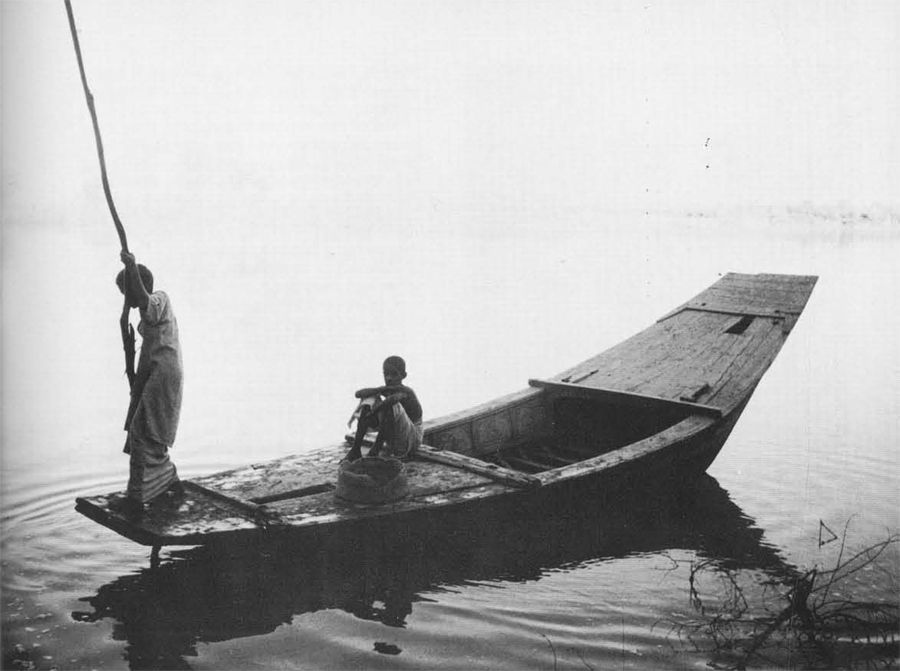
Although we cannot be certain of the location of the original home of the Indo-Aryans, we are in a position to be more definite about their occupation of the northern part of the Indo-Pakistan subcontinent. For here, evidence of the Rig-Veda helps us, as the hymns in it contain certain geographical data throwing light on the area where their early centers were located. In order to ascertain the extent of their settlements, we should consider the references in the Vedas to the rivers of the Indo-Gangetic plain, the tribes that lived there and the way of life led by the Indo-Aryans. This long “hiatus” however, remains to be filled through archaeological investigations.
What should be the next step? The answer is obvious. For the investigation of this difficult problem, two main considerations control the choice of a site which could possibly give some clue to its solution. First, the site should be situated on or near one of the highways leading from Iran and Afghanistan to the northwestern part of the Indus Valley and Baluchistan. Secondly, the site should be sufficiently high and known to have survived in its latest stages down into the historic period from prehistoric times, preferably through some of the intermediary phases.
A great site in Baluchistan fulfils these conditions and offers excellent opportunities for future work in this direction. It is called Dabar Kot and is located in the Loralai district of Baluchistan. Situated on the highway leading from Kandahar to Baluchistan and thence to the Indus Valley, the site is represented by a great mound over a hundred feet in height.
That the habitation area here originally extended far beyond the ground covered by the existing mound is shown by the wide area all around strewn with pottery. Here, Sir Aurel Stein’s summary excavations in 1927 revealed, among other characteristic groups of pottery, one type which seems to be pre-Harappan, found in association with distinctive terracotta female figurines which frequently occur in other sites of Baluchistan.
The second group of material shows affinities with Harappan pottery and Harappan seals. The pottery of the latest period indicates evidence of the Sassanian culture. This great mound requires a thorough examination down to its lowest levels. Only then may we be able to indicate the progressive development which took place from prehistoric times through the third millennium B.C. to the 3rd-4th century A.D.
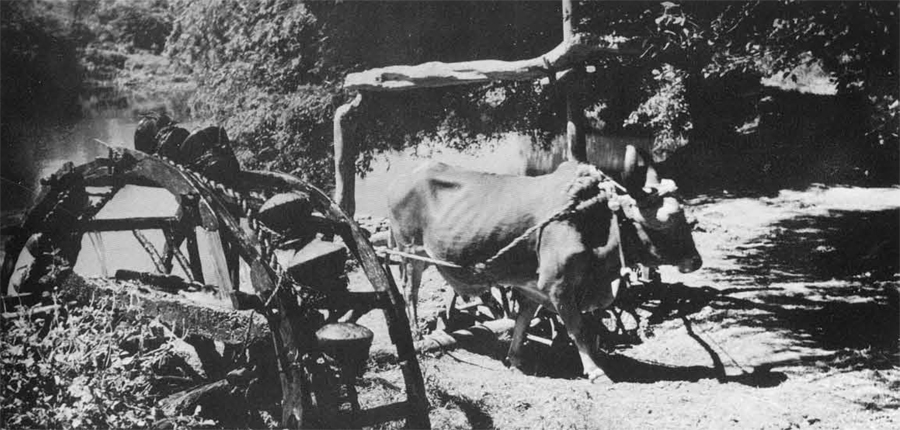
In dealing with the beginning of the historic period of West Pakistan, excavations at Bhir Mound, the earliest of the three city-states of Taxila, in the Gandhara region provide abundant and clear evidence that it flourished for a considerable time before the invasion of the Greeks under Alexander the Great in 326 B.C. From that time onward the history of this part of Pakistan is fairly well documented.
In 80 B.C., the Indo-Greeks who ruled over Gandhara were swept away by the Scythians of the Sakas; and in A.D.60 the Kushans established their rule. The White Huns brought great destruction to this country around A.D. 455. As regards the sites and settlements of this period, just a few have been subjected to excavation and a large number of them remain to be surveyed and properly investigated.
Coming to the early Muslim period, the political history and the story of the Arab invasion of the Indus Valley in the beginning of the 8th century A.D. is reasonably clear. But of the cultural side of that period we as yet know very little indeed. It is a well-known historical fact that within a few centuries after the advent of Islam in the Near East, the Muslim world included Arabia, Mesopotamia, Syria, Egypt, North Africa, Spain, Iran, the Trans-Oxus, Turkey, and the southern parts of the former provinces of Sind and the Punjab in West Pakistan.
In all these countries were to be found thriving industries and commercial prosperity. The crafts were represented by works in plaster and mosaic, in marble and stone, in glazed ceramics and tiles, and in metal and glass. It is evident, then, that in the countries conquered by the Muslims, the peoples were highly skilled in different arts and crafts. There the Muslims not only came into possession of industries of the local craftsmen but also acquired, what was far more precious and essential, the living knowledge and skill possessed by the natives.
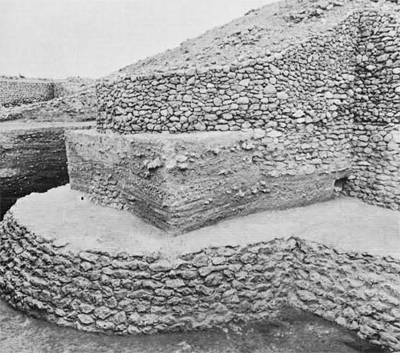
It was this knowledge and skill, which, when incorporated by the Muslims into their culture, was to re-express itself in the blended form of Muslim arts and crafts including architecture. The new features, wherever they are found, have a distinctive character of their own. Unfortunately, in West Pakistan, known evidence of the corresponding arts and crafts of the 8th to 13th centuries A.D. is extremely scarce.
After the conquest of the famous port of Debal in A.D. 711-12 by the young General Mohammad-bin-Wasim, the Arabs advanced up-country and subdued in less than two years such Hindu cultural centers as Nirun, Sehwan, Aror, Uch, and Multan. Of the cities mentioned by the Muslim geographers, only two have been submitted to partial excavation. One of them is Brahmanabad, 45 miles northeast of Hyderabad, and the other is Banbhore (Bhambore), 40 miles east of Karachi, on the right bank of the Gharo Creek. On the former site, the excavation work undertaken in 1903-04 was of a summary nature. At the latter site, excavations that have been conducted yearly since 1958 by the Department of Archaeology, have revealed remains of the earliest known mosque (dated 109 Hijra, or A.D. 727) of the Indo-Pakistan subcontinent, and city defences with bastions and residential quarters.
The finds include inscriptions in Kufic style; copper and silver coins of the Umayyad and early Abbasid Caliphs and their local governors and also of the Sassanians; a gold coin of Wasiq Billah (A.H. 227-232–A.D. 842-847); glazed and unglazed pottery and glass work of the early Muslim period. The pottery includes specimens of Chinese stoneware, porcelain, and celadon which may have been imported in the 9th-10th centuries A.D. This evidence is of great significance. It attests that Banbhore had been an important port where traders brought their goods not only from the Mesopotamian and Persian Gulf ports but also from those of distant China.
The contrast between the culture of the pre-Muslim and the Muslim periods is quite distinct, but the precise moment of the first contact of the Muslims with the Hindu-Buddhist life has not yet been fully determined. Certainly, further work is needed on more than one site to complete our picture of the early Muslim culture of West Pakistan and the changes which it introduced.
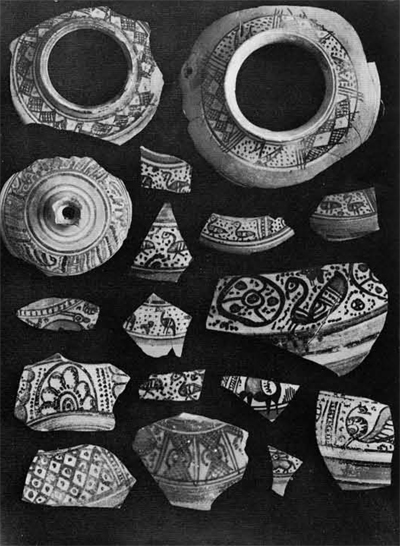
The first task in this direction, then, should consist of extensive field reconnaissance in southeast Iran, Baluchistan, and the Indus Valley in order to find other sites of this period. On the strength of this field work, it would then be possible to determine the extent to which Muslim culture penetrated into the Indus Valley. This should be followed by intensive excavations at either Sehwan, Aror, or Multan.
The archaeological problems of East Pakistan are fundamentally different from those of West Pakistan where at least we know the nature of the problems which demand our attention. In East Pakistan there is no precise information of the succession or distribution of ancient cultures. At present we have no knowledge of the pre-historic period of that part of the country, and the earliest cultural evidence so far discovered is represented by the extensive remains of Mahasthangarh in Bogra district.
Here, in spite of the summary nature of the investigations, the oldest datable find of East Pakistan was discovered in 1931. This is a fragment of a stone slab inscribed with five lines of writing in Brahmi script, which resembles the third century B.C. script of the Asokan edicts. It is a find of great historical significance, but unfortunately its chronological position cannot be related to other cultures in East Pakistan before and after the 3rd century B.C. From that period onwards there is a gap in the history of the country.
The Guptas held sway over East Bengal from the 4th to 7th century A.D., and at Mahasthangarh the excavated remains of a brick temple decorated with sculptured terracotta plaques are ascribed to them. The Khadgas are said to have ruled after the Guptas, but the exact date of their rule has not yet been ascertained. After the Khadgas and before the establishment of the Pala rule there exists a void in the political history of East Bengal that has to be bridged.
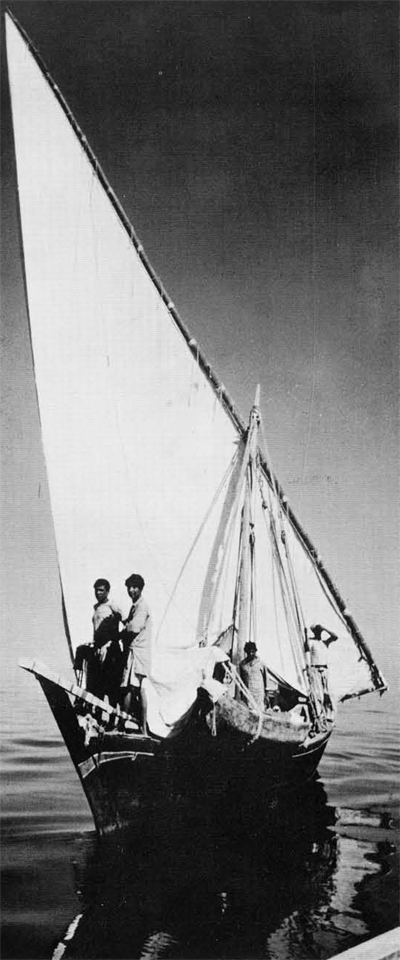
In North Bengal the Palas, who came to power in the 8th century A.D., built the city defence at Mahasthangarh and the famous Paharpur cruciform brick shrine. Their contemporaries in South Bengal, the Devas, established their great religious centers on the Mainamati-Lalmai Hills near Comilla.
After the downfall of the Palas and the Devas, East Bengal seems to have passed under the Chandras, who in their own turn were ousted in the 11th century A.D. bu the Varmans. The Senas succeeded them. The Muslim conquest of that part of the country put an end to their rule in A.D. 1202.
It is thus seen that there are archaeological gaps after the post-Asokan and pre-Gupta periods in the history of East Pakistan, and although the political history of the post-Gupta period is well recorded, the ground has not revealed many remains. In East Pakistan, therefore, the task is to collect the available historical data about the ancient remains. Then, extensive exploration should be undertaken all over the country with a view to tracing ancient sites and settlements. This will be the preliminary step for the identification of cultures and their distribution.
From the results of this task, it will then be possible to decide which sites offer scope for intensive investigation. In the present state of our knowledge, the Mahasthangarh site seems to embrace a fairly long period of occupation, but further field may well reveal other important sites.
Near Comilla town, on the Mainamati Ridge, there is a group of more than fifty sites spread over an area about eleven miles long. Here, somewhere once stood Pattikera, the favorite center of the Chandras in the 9th and 10th centuries A.D. The ruins, brought to light by a chance discovery during World War II, consist of Buddhist religious establishments decorated with terracotta plaques in the style of the Paharpur panels. The small finds include an interesting collection of bronze votive images of the Buddha and other Buddhist personages.
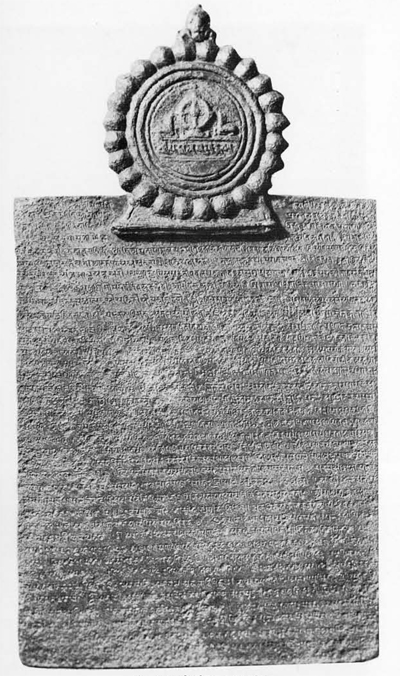
The various sites at Mainamati appear to be of great historical interest, but their chronological sequence cannot be determined without extensive systematic excavations. The style of terracotta plaques, however, suggests a date between the 8th and 10th centuries A.D. It was with a view to determining the chronological sequences of these sites and solving other allied problems that excavations were begun in 1955 by the Department of Archaeology at the Salban Vihara, and other promising locations.
In summary, certain proposals aiming to solve the outstanding problems of explorations and excavations in Pakistan may be briefly indicated.
In West Pakistan, the search for pre-Harappan and Harappan sites should be extended to the Bahawalpur region east of the Indus River; systematic excavation of a large site in Baluchistan–preferably Dabar Kot–is essential; extensive surface collections must be made for comparative study and display pieces. The materials previously collected by Sir Aurel Stein and N.G. Majumdar are now in India; exploration and excavation should be directed toward post-Asokan (Buddhist) sites in the Gandhara region; early Muslim settlements in Central Baluchistan and the Indus Valley should be sought and excavations made at one of the important early sites mentioned by the Muslim geographers.
In East Pakistan, extensive exploration is required to determine the distribution of prehistoric and historical settlements; excavations should be extended to other sites on the Mainamati Ridge to provide more information on the Deva rulers of the 8th century A.D.; excavations should be expanded at Mahasthangarh to fill the historical gap between the Asokan and Gupta periods.
These are some of the basic problems which are being tackled by the Department of Archaeology in Pakistan.
